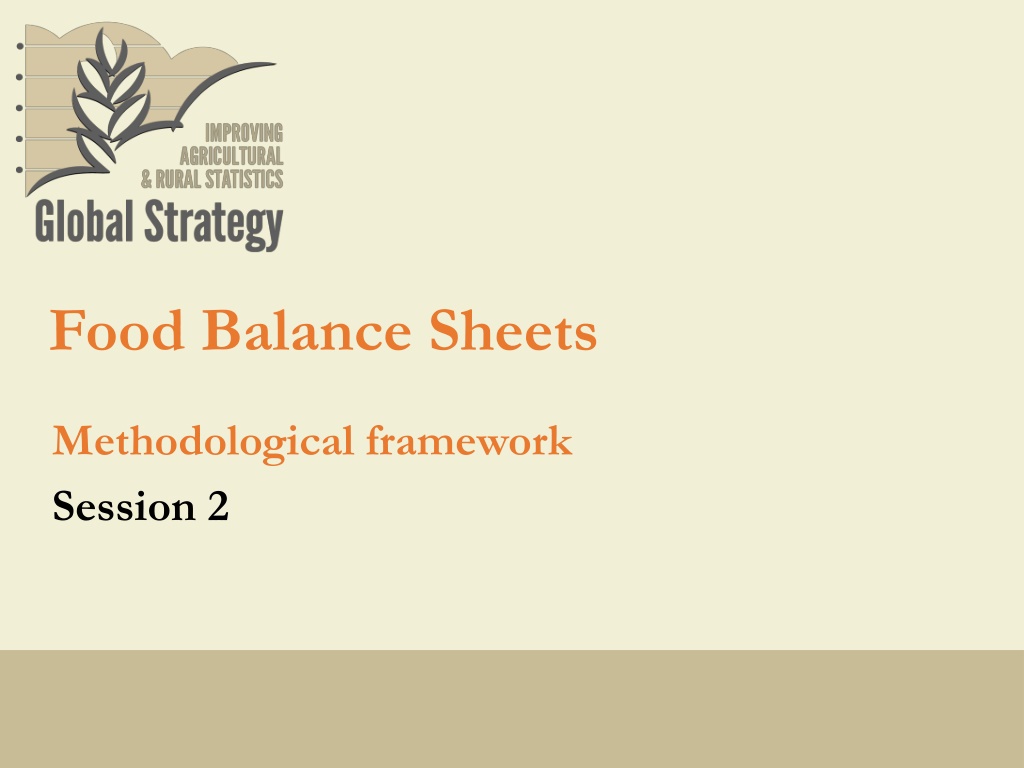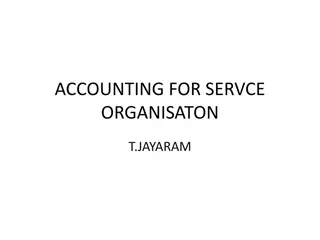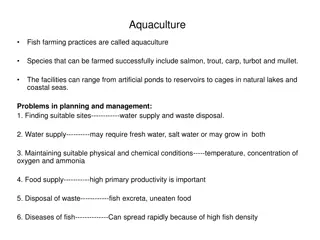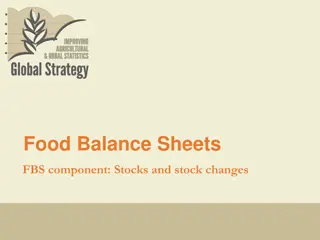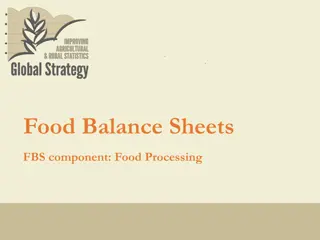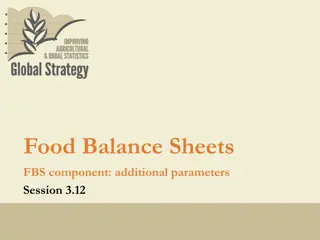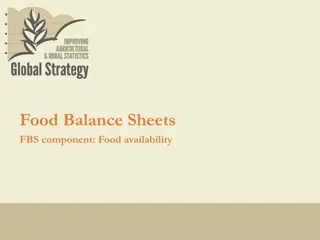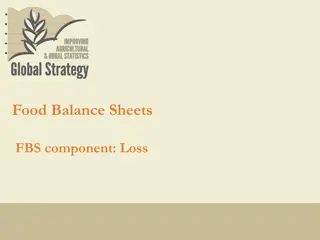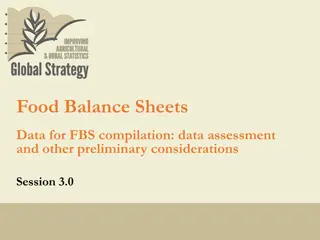Understanding Food Balance Sheets and Supply Utilization Accounts
This session focuses on the methodological framework of Food Balance Sheets (FBS) and Supply Utilization Accounts (SUAs). Participants will learn about compiling FBS, differences between SUA and FBS, the linkage of commodity trees, recommended balancing mechanisms, and more. The content covers basic identities, definitions of FBS components, additional variables, and the connection between SUAs and FBS. It delves into the balancing mechanisms essential for accurate data representation in food supply and utilization analysis.
- Food Balance Sheets
- Supply Utilization Accounts
- Methodological Framework
- Balancing Mechanisms
- Commodity Trees
Download Presentation

Please find below an Image/Link to download the presentation.
The content on the website is provided AS IS for your information and personal use only. It may not be sold, licensed, or shared on other websites without obtaining consent from the author. Download presentation by click this link. If you encounter any issues during the download, it is possible that the publisher has removed the file from their server.
E N D
Presentation Transcript
Food Balance Sheets Methodological framework Session 2
Learning objectives a) At the end of this session, the participants will: b) Know all the relevant concepts involved in compiling FBS c) Be able to understand the difference between supply utilization accounts (SUA) and Food Balance Sheets (FBS) d) Understand how commodity trees link SUA back to the primary commodity equivalent-level FBS e) Know the recommended balancing mechanism and their alternatives 2
Outline I. Basic identity and approach II. Definitions of FBS components III. Additional variables IV. Supply Utilization Accounts (SUAs) and link with FBS V. Balancing mechanisms 3
I. The basic identity and approach 4
I.1. The basic identities FBS are built on the two basic premises: Sum of all aspects in the supply of a given product = sum of utilizations for that product It is compiled for a given country in a given year Two different basic identities: Total domestic supply = Total domestic demand Total supply = Total demand 5
I.1. The basic identities Domestic supply = Domestic utilization ???+ ? + ? ? = ??+ ??+ ??+ ? + ?? + ??+ ??? + ??? Total supply = Total utilization ???+ ? + ? = ? + ??+ ??+ ??+ ? + ?? + ??+ ??? + ??? ???= opening stocks, P = production, I = imports, X = exports, ??= food, ??= feed, ??= seed, T = tourist food, IU = industrial use, ??= Loss, ROU = residual other use, and ???= closing stocks Food processing could be including in the utilization part of the equation but this variable is typically dropped in the final stages of FBS compilation 6
I.1. The basic identities Supply (t) Utilization (t) Supply (t) Utilization (t) opening stocks production imports exports feed seed loss processing food industrial use other utilization closing stocks tourist food opening stocks production imports - exports feed seed loss processing food industrial use other utilization closing stocks tourist food Domestic supply Domestic utilization Total supply Total utilization 7
I.2. Recommended approach Many countries do not collect data on stock levels for the majority of products For this reason supply = utilization identity is often expressed using some estimate of the change in stock levels during the reference period 8
I.2. Recommended approach Domestic supply = Domestic utilization ? + ? ? ???= ??+ ??+ ??+ ? + ?? + ??+ ??? Total supply = Total utilization ? + ? ???= ? + ??+ ??+ ??+ ? + ?? + ??+ ??? Where ???= ??? ??? 9
II.1. Supply and use variables: Introduction Exact definition of the concepts is warranted Countries should try to adhere to the guideline s definitions where possible Example of not adherent definitions: Underestimation of the supply of some products when reporting only commercial production 11
II.2. Supply and use variables: Production Data for production should include: all production quantities of a given commodity within the country both commercial and non-commercial production Production of primary products: reported at the farm gate level (so it does not include harvest losses) o It should include: any post-harvest on-farm loss occurring during the different farm operations, such as threshing, cleaning/winnowing or storage Data for meat production: both commercial and farm slaughter production should be expressed in terms of carcass weight 12
II.2. Supply and use variables: Production Production of derived or processed commodities: refers to the total output of the product after transformation may occur either at the household or at a commercial establishment The standard unit for the reporting of agricultural production is metric tonnes (MT) But many countries also use local units 13
II.3. Supply and use variables: Imports and exports Imports transboundary flows of goods destined for a given final destination country that add to the total supply of goods available in that country Exports transboundary flows of goods from a given country of origin that take away from the total availability of goods in that country Goods that come in and exit a given country without having undergone any type of transformation are therefore excluded from these definitions. These exits are categorized as re-exports 14
II.4. Supply and use variables: Stocks Stocks aggregate total of product allocated to storage for use at some future point in time. can be held by a variety of actors (governments, manufacturers, importers, exporters, resale or wholesale merchants, farmers) Two ways for accounting stocks: stock levels at both the beginning and end of the period estimating the change in stocks from one time period to the next (as a component of supply) 15
II.5. Supply and use variables: Food availability Food availability quantity of an edible product that is available for human consumption during a given reference period Include: 1) amount of food that is available for consumption at the retail level 2) food consumed in restaurants and institutions (hospitals, schools, military bases, prisons, etc.) 3) may include non-edible parts (the calorie conversions applied should take this fact into account) 16
II.5. Supply and use variables: Food availability Waste (and/or loss) that occurs at the retail or consumer levels is not included in this quantity The quantities reported represent those available for food (typically higher than quantities reported through household-level surveys) 17
II.6. Supply and use variables: Food processing Definition of Food Processing: quantities of an edible product that are directed toward a manufacturing process and are then transformed into a different edible commodity with a separate entry in the food balance sheet Food processing commodities: might be structured within the same commodity tree or food group (e.g., tomatoes that are processed into tomato paste) Or they could be completely separate Example: barley is processed into beer, which typically is aggregated into an alcoholic beverages category and not into the barley balance 18
II.6. Supply and use variables: Food processing The food processing variable should disappear in the final stages of FBS compilation to avoid double-counting The food processing variable should remain in the final account Quantities devoted to the manufacture of non-edible products (such as soap or biofuels): accounted for under industrial use and not food processing 19
II.7. Supply and use variables: Feed Feed Quantities of commodities both domestically produced and imported that are available for feeding to livestock Mainly products of industrial process (oilcake, dregs, or distiller s dried grains with solubles) Included in initial calculations but most will not be aggregated up to the primary commodity level in order to avoid double counting 20
II.8. Supply and use variables: Seed Seed any quantity of a commodity set aside for reproductive purposes in the following year seed for sowing, plants for transplanting, eggs for hatching, and fish used as bait double or successive sowing should be also take into account Must be non-zero if production (area harvested) in t+1 is nonzero Strongly correlated with production (area harvested) in t+1 21
II.9. Supply and use variables: Tourist food tourist food food that is consumed by non-resident visitors to a given country during the course of their stay expressed in net terms: consumption of incoming tourists minus consumption of residents as tourists in other countries Countries with negligible numbers of visitors may choose not to estimate tourist food Example of small island states accounting for tourist food is essential to accurately estimating local consumption patterns. 22
II.10. Supply and use variables: Industrial use Industrial use Any quantity of a given product used in some non-food transformation or manufacturing process Includes biofuels, cosmetics, detergents, or paints 23
II.11. Supply and use variables: Loss Loss any quantity of a product that leaves the supply chain and is not diverted to other uses result from an involuntary activity can occur at any node of the supply chain after the harvest and up to (but excluding) the retail/consumption stage Include both edible and non-edible parts can also be referred to as post-harvest or post-slaughter losses Don t include any quantities of food wasted or lost at the consumer or retail level 24
II.11. Supply and use variables: Loss Volume of product lost in the transformation of primary products into processed products is accounted Taken into account in extraction rates and conversion factors Loss that occur in all other utilizations (particularly during storage and transportation) are included 25
II.12. Supply and use variables: Residual and other uses Residual and other uses: any uses other than those described above more appropriately defined by what it is not rather than what it is Utilize this category to capture small amounts of product use that are otherwise unaccounted for Example: for countries with negligible numbers of tourists, tourist food could be included under this residual category 26
III.1. Additional variables Additional variables are needed for the estimates of per capita nutrient availability Population (UNPD) Population in a country, area or region as of 1 July of the year indicated Nutrient Estimates Estimates derived from the final food estimates in the balance sheet for each product by applying certain conversion factors to those quantities 28
III.3. Additional variables: Nutrient estimates Nutrient conversion tables: (http://www.fao.org/fileadmin/templates/ess/ess_test_folder/Food_secu rity/Excel_sheets/Nutritive_Factors.xls) Food: total calorie equivalent Calories per capita per day Food: total protein equivalent Proteins per capita per day Food: total fat equivalent Fats per capita per day 29
III.4. Additional variables: Activity and productivity variables Compilers should also collect data on other relevant variables that could be necessary for: 1. The imputation of missing values 2. Validation of main production variables Productivity variables Activity variables Crops: Yield in MT/HA Livestock: carcass weight and take- off Crops: area sown, area harvested Livestock: number of animals 30
III.5. Additional variables: Extraction rates Extraction rates (an element of technical conversion factors) parameters that reflect the loss in weight in the conversion (or processing) of one product into another Expressed as a percentage ?????????? ???? =???????? ?? ?????? ???????? ?? ????? Example: To produce 80 MT of maize flour, 100 MT of maize are needed: the extraction rate is 80 percent. 31
III.5. Additional variables: Extraction rates Key components of FBS calculation the production of processed products from primary ones conversion of derived product quantities back up to primary product equivalent Several output products may be produced from a single transformation process of one input good The cumulative extraction rate is less than 100 percent Example of maize flour transformation process: production of flour, maize bran and maize germ 32
III.6. Additional variables: Processing shares Percentages of the amount of a given commodity sent to processing Necessary for FBS goods can be processed into an array of derived products the input used for the production of these derived goods is seldom known with certainty Processing shares + extraction rates estimate of the production of derived goods when very little information exists 33
IV. Supply Utilization Accounts (SUAs) and link with FBS through standardization using commodity trees 34
IV.1. Supply Utilization Accounts (SUAs) FBS SUA Publish at the primary commodity equivalent level The accounting balances for individual products are called Supply Utilization Accounts (SUAs) Doesn t provide a holistic picture on how the commodity is being consumed, traded, or otherwise used after being processed into various derived products Supply and demand occurring for each products, both primary and derived 35
IV.1. Supply Utilization Accounts (SUAs) SUAs are used to prepare a number of statistical measures and outputs, including Trade Yearbook Production Index Numbers SUAs Production Yearbook Import Dependency Ratios Self-Sufficiency Ratios Food Balance Sheets 36
IV.1. Supply Utilization Accounts (SUAs) Example of a sample blank SUA table for potatoes: Food processi ng Net Tourist Cons. Produc tion Stock change Industria l Use Product Imports Exports Food Feed Seed Loss Soybeans - - - - - - - - - - - Oil of soybeans - - - - - - - - - - - Cake of soybeans - - - - - - - - - - - Soy sauce - - - - - - - - - - - Margarine & shortening - - - - - - - - - - - Hydrogenat ed oils and fats - - - - - - - - - - - 37
IV.1. Supply Utilization Accounts (SUAs) SUAs can include several different levels of processing Example Soybean : processed into soybean oil and cake, or processed into soy sauce Soybean oil processed into margarine/shortening or hydrogenated oils and fats Each of these subsequent processing levels is linked back to the previous level through an extraction rate 38
IV.1. Supply Utilization Accounts (SUAs) The accounts cannot simply be added together to arrive at one primary equivalent balance Balances are elaborated by weight in MT of primary commodity- equivalents One MT of a derived product is not equivalent to one MT of the primary commodity Example of a hypothetical customer who is interested in buying a large quantity of orange juice Company X sells both fresh oranges and orange juice They offer to sell the customer either 100 MT of fresh oranges or 100 MT of orange juice for the same price 39
IV.1. Supply Utilization Accounts (SUAs) Company X offers to process the fresh oranges into juice free of charge at an extraction rate of 55 percent (that is, 0.55 MT of juice output per 1 MT of fresh orange input). FBS compilers will recognize that the customer should most definitely choose the juice instead of the fresh oranges because 100 MT of fresh oranges will only yield around 55 MT of juice after processing This calculation can be done by: ???????? ?? ?????? = ???????? ?? ????? ?????????? ???? ???????? ?? ?????? = 100 MT fresh orange 0.55 MT orange juice 1 MT fresh orange ???????? ?? ?????? = 55 MT orange juice 40
IV.1. Supply Utilization Accounts (SUAs) Non-equivalence between 100 MT of orange juice and 100 MT of oranges can also be seen by working backward from the amount of juice. In order to produce 100 MT of orange juice, about 182 MT of fresh oranges would be needed as input. ???????? ?? ?????? ?????????? ???? ???????? ?? ????? = 100 MT orange juice 0.55 MT orange juice 1 MT fresh orange ???????? ?? ????? = ???????? ?? ????? = 182 MT fresh orange 41
IV.1. Supply Utilization Accounts (SUAs) Steps: 1) Derived products converted back to their primary commodity equivalent All of the primary commodity equivalents can be added together to arrive at one overall balance 2) Derived products can be converted back to their primary commodity equivalents simply by dividing by the extraction rate (as in the example) 42
IV.1. Supply Utilization Accounts (SUAs) This process of converting derived products to a primary equivalent so that they can be added up is called vertical standardization. FBS for primary equivalent products are created by standardizing and adding up individual SUAs for derived products ???????? ?? ??????? ??????? ?????????? ???? ??????? ????????? ?????????? = 43
IV.1. Supply Utilization Accounts (SUAs) This linking of primary to derived commodities using extraction rates is fundamental to the FBS compilation process. Simple to understand if there is only one derived good. Most food manufacturing commodities produce multiple outputs Even possible for those outputs to undergo further transformation into second- tier derived goods. Commodity trees to better conceptualize and organize the compilation of FBS 44
IV.2. Commodity trees Commodity trees stem from one primary product and then branch out into one or successive levels of processed products each level linked by extraction rates Designed to be exhaustive, such that all processing uses of a particular commodity are covered 45
IV.2. Commodity trees Example of mushroom commodity tree 46
IV.2. Commodity trees The transformation processes for many derived products commonly have two (or even three) outputs. Multiple products that are produced from a single transformation process are called co-products Co-products commonly produced in: milling of cereals (flour milling also produces bran) oilseed crushing (where both oil and cake are produced), among others 47
IV.2. Commodity trees Example of olive commodity tree 48
IV.2. Commodity trees The tree structures for nearly all commodities that undergo processing are available on FAO s website (http://www.fao.org/fileadmin/templates/ess/documents/methodology /tcf.pdf) Countries are encouraged to review those trees and update them as necessary for their purposes. country-specific extraction rates should be added. Extraction rates of neighboring countries in absence of extraction rate estimates for the country 49
IV.3. Processing shares Processing share: percentage of the amount of a given commodity sent to processing that is thought to be dedicated to a specific transformation process Used to calculate the amount of input used for a given transformation process, as below ? ????? ??? ? = ? ?? ? ???? ?? ?????????? ? ? ?????????? ? ??? 50
